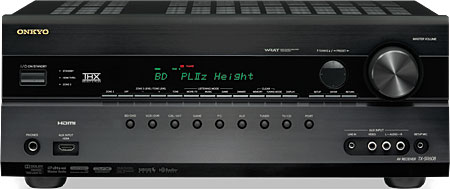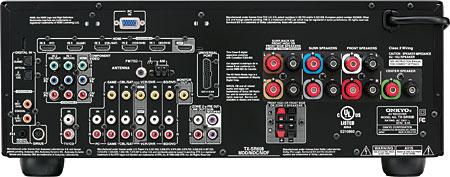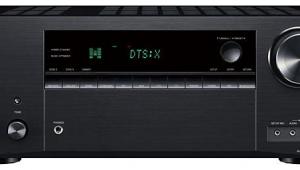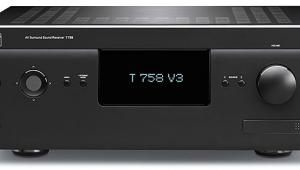Onkyo TX-SR608 A/V Receiver
 Price: $599 At A Glance: First THX-certified 3D-capable AVR • HDMI 1.4a includes all current 3D formats • Width or height processing via Audyssey DSX
Price: $599 At A Glance: First THX-certified 3D-capable AVR • HDMI 1.4a includes all current 3D formats • Width or height processing via Audyssey DSX
THX and 3D

Many tributaries feed the mighty Mississippi. South of the Twin Cities, the Minnesota River gushes in. In Wisconsin, it is joined by the St. Croix River, the Black River, the La Crosse River, the Root River, and the Wisconsin River. Then come the Rock, Iowa, Skunk, Des Moines, Illinois, Missouri, Ohio, Tennessee, Platte, Arkansas, Yazoo, and Atchafalaya rivers—all gliding in until the increasingly vast Mississippi ends its epic American journey at the Gulf of Mexico. I’m typing out all of this for two reasons. Contemplating the American landscape is an awe-inspiring pleasure—and pleasure is what I’m all about.
Plus I’m reaching for a metaphor to dramatize just how many technological tributaries flow into the Onkyo TX-SR608 A/V receiver.In a historical sense, this is the first AVR to combine THX certification with 3D. Frankly, they don’t have much to do with each other, but really, what do the Skunk River and the Atchafalaya River have to do with each other aside from the fact that they both flow into the Mississippi? There must be some comfort in knowing that your system can perform to tough THX Select2 Plus specs and at the same time provide the sensation of things whizzing right out of the screen.
This AVR is among the first with HDMI 1.4a certification, so it is specified to pass through every type of 3D signal available at press time. This includes fullresolution 3D from Blu-ray plus the side-by-side and top-and-bottom formats that have just been adopted for broadcast use (I didn’t test this as I am not set up with a 3D source or display currently). Faroudja DCDi video processing is also included. Further sensory stimulus comes from Audyssey, itself a whole bunch of tributaries loaded with reliable auto setup and room correction (2EQ), low-volume listening modes (Dynamic Volume and Dynamic EQ), and to provide a little adventure, a choice of width- or height-enhanced listening modes (DSX). With Dolby Pro Logic IIz along for the ride, the most compulsive tweakers can while the night away comparing Dolby’s height mode to Audyssey’s.
This exhaustive feature set comes at the modest price of $599. It continues an Onkyo tradition of packing the latest and hottest stuff into an affordable package. If Mark Twain could get two great American novels out of the Mississippi, then surely, in my own humbler way, I can get a review out of all that.
He’s Not Heavy
The TX-SR608 isn’t especially large or heavy—one thing $599 doesn’t buy is a lot of brawn. Still, at a rated 100 watts per channel, it’s slightly more powerful than its 90-watt-per-channel predecessor. This is the first Onkyo AVR at this price point to feature Darlington output technology, which was previously limited to higher-priced models. According to Onkyo’s international Website, the implementation is a three-stage inverted Darlington, lownegative-feedback design that produces “more natural” sound.

Let’s go into detail about this A/V receiver’s HDMI 1.4a status. It does 3D without a firmware update—cue loud applause. It also has the Audio Return Channel, which lets the HDTV return audio signals from its onboard tuner to the AVR for surround processing. But it doesn’t include the HDMI Ethernet Channel, which would have allowed this AVR to share data and an Internet connection with other devices.
THX Select2 Plus certification ensures that this A/V receiver can reach output levels of up to 105 decibels when used with THX Select2-certified loudspeakers in a room of 2,000 cubic feet or less with a viewing distance of 10 to 12 feet. The Plus designation indicates the presence of THX Loudness Plus, a low-volume listening mode that preserves the integrity of certain parameters when the AVR plays below the THX reference level (which many of us find deafening). THX Loudness Plus includes both Multi-Channel Spectral Balancing (equalization that keeps lows and highs audible) and Dynamic Ambience Preservation (adjusting spatial detail via surround levels).
Onkyo evidently values low-volume listening modes because it has also licensed two more. Audyssey Dynamic EQ and Dynamic Volume work hand in hand. The former preserves bass and tonal clarity, two things that tend to diminish at low volume levels unless adjusted. The latter maintains consistent volume levels so that you can listen to dynamically challenging movie soundtracks without constantly upping the volume to catch dialogue and then lowering it to withstand aggressive effects. Both build on the foundation of Audyssey 2EQ, an auto setup and room-correction technology that takes measurements from three listening positions (the step-up MultEQ measures from up to six positions). I’ve discussed Audyssey DSX (with its width and height enhancement) and Dolby Pro Logic IIz (another approach to height enhancement) in detail in past reviews. See my reviews of the Denon AVR-4310CI (HT, November 2009) for DSX and the Onkyo TX-SR607 (HT, August 2009) for DPLIIz.
One new feature is HDMI Thru, which passes content to the HDTV even when the AVR is in standby mode. This might be handy if, for instance, you want your cable box to deliver a news broadcast using just the HDTV’s built-in speakers. It also might be helpful for family members who want to watch HDTV without operating the AVR.
With so many listening modes and options, you might fiddle a lot. While it’s attractive and functional, the GUI could still make some things simpler. For example, you have to access THX Loudness Plus via Main Menu/Speaker Setup/THX Audio Setup/Loudness Plus—while you access Audyssey Dynamic EQ/Volume from Main Menu/Source Setup/Audyssey/Dynamic EQ or Dynamic Volume. Fortunately, the remote includes a button that accesses Dynamic EQ/Volume and other oft-used settings with a simpler monochrome menu and fewer keystrokes. Other remote buttons cycle among the Dolby, DTS, and THX listening modes, with the Dolby (DPLII/x/z) and DTS (Neo:6) modes functioning either alone or in combination with THX’s Cinema, Music, and other modes.
Onkyo is considerate in other respects. Its AVRs come with a poster-size full-color Quick Setup Guide that offers an alternative to the not-bad main manual. You also get a sheet of adhesive speaker cable tags with appropriate color coding that matches the Quick Setup Guide and the rearpanel labeling.
Before the demos, I ran Audyssey 2EQ. The process isn’t entirely automatic because you need to specify how you’re going to use the last two of the AVR’s seven channels. Plug in the microphone, and three fields appear: (1) The Onkyo asks you whether the front left and right speakers will be biamplified (which would use the two extra channels) or normal. (2) Choose front height channels (DSX/DPLIIz), front width channels (DSX), or zone two. (3) If you chose front height in the second field, the third one will offer a choice of front width or surround back. If you chose front width in the second field, the third one will offer a choice of front height or surround back. If you chose zone two in the second field, the third one will offer height, width, or back.
All of the above might lead you to believe that the AVR can operate many of these options (biamp, height, width, back surround, zone two) at the same time. Although it has nine sets of speaker terminals, it only has seven amp channels. However, you can wire your system for at least two of these beyond5.1 options (say, both height and width) and then use one at a time.





























































